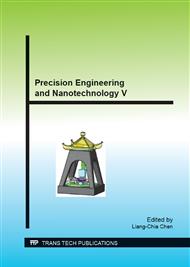p.559
p.564
p.570
p.576
p.581
p.587
p.593
p.597
p.603
Improvement of Drill Life for Nickel Super Alloy by Ultrasonic Vibration Machining with Minimum Quantity Lubrication
Abstract:
In this study, drilling for nickel alloy was carried out with ultrasonic vibrating carbide drill. Micro drilling is not an easy machining process due to remarkable tool wear, lower stiffness of the tool, difficulty of chip and heat removal from cutting point. Ultrasonic vibration assisted machining has effects of decrease of cutting force, generation of fragmented small chip, extension of tool life and improvement of surface integrity. In this study, ultrasonic vibration drilling for nickel super alloy was investigated to improve the tool life and productivity. The drilling for heat-resisting nickel super alloy was performed with the drill of 0.3mm in diameter. As a result, ultrasonic vibration drilling performed 302 holes with thickness of 2.0mm by applying minimum quantity lubrication to blow off the chips on the flutes. Ultrasonic vibration improved deviation of position of drilled hole because the hammering motion of the chisel edge results in good bite of tool on work surface. The productivity is directly depends on feed rate. The increasing feed rate from 6mm/min to 60mm/min dramatically reduced the tool life one thirtieth under conventional drilling condition. On the other hand, the ultrasonic vibration drilling reduced the tool life only one half.
Info:
Periodical:
Pages:
581-586
Citation:
Online since:
August 2014
Authors:
Price:
Сopyright:
© 2015 Trans Tech Publications Ltd. All Rights Reserved
Share:
Citation:


